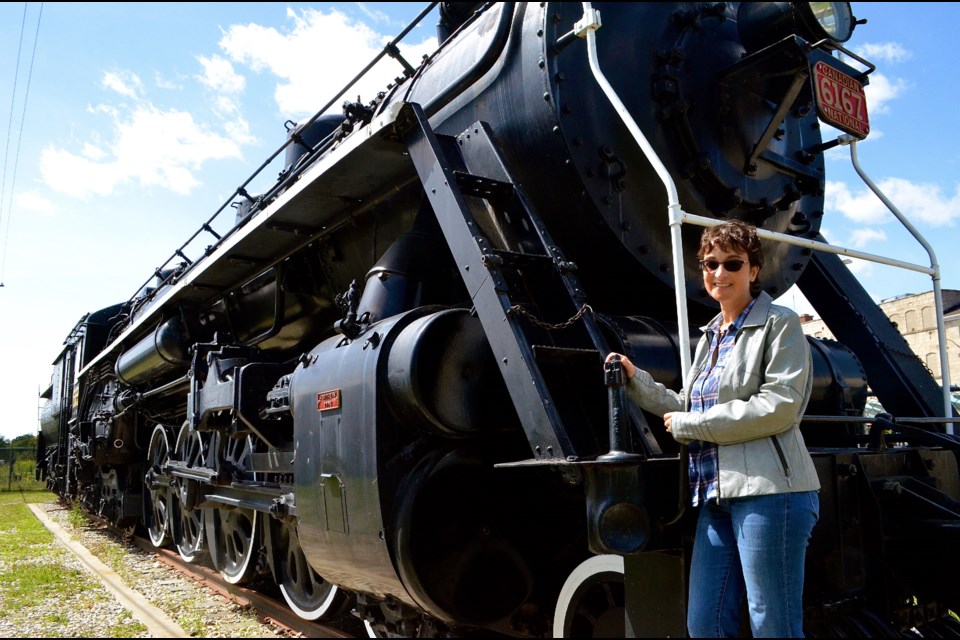The journey of Locomotive 6167 began in 1940 and covered more than 2 million kilometres before it was retired from service in 1964.
“It was gifted to the city in 1967 as a Centennial gift from CN Rail,” said Danna Evans general manager of Culture, Tourism and Community Investment for the City of Guelph. “It has been a part of the community ever since.”
The locomotive that consists of two sections, the engine and the tender, has been parked next to the city’s main rail lines southeast of Guelph Central Station since 2012. The property is owned by Metrolinx and in December 2018, the city was told the train had to be moved.
“We have been given notice by Metrolinx that we need to move the locomotive by December 2020,” said Evans. “Even though we were given two years notice it is still pretty quick for the size. I can suggest that moving almost 500,000 lbs of history will take time and funding.”
According to an updated report set to go before council Tuesday the funding required to move 6167 works out to approximately $1.30 a pound.
“We are estimating $650,000 right now,” said Evans. “There are lots of pieces involved. The main costs are the move itself. We are looking to get a buy in from council about moving it to John Galt Park.”
Locomotive 6167 was one of 203 “Northern” locomotives owned and operated by Canadian National Railways. The steam locomotive was built in 1940 at the Montreal Locomotive Works and used for both passenger and freight service. It served the war effort during the Second World War hauling troops and supplies to eastern ports.
“It didn’t run through this area at that time,” said Evans. “It was based in Moncton, New Brunswick for most of its life as a working train, transporting for war time as well as for commuters.”
On the afternoon of July 6, 1943 Locomotive 6167 was traveling east at full speed when it collided head on with its sister Locomotive 6166 traveling westbound near Montmagny, Quebec. The collision killed 6167’s engineer and two others and many passengers and crew were injured. Both locomotives were heavily damaged but 6167 was quickly repaired and returned to serving the war effort.
It remained in service until 1960 when CN replaced all of its steam engines with diesel engines. Rather than retiring the battered locomotive CN repurposed 6167 for special excursion trips to scenic locations throughout Ontario. From 1960 to 1964 it carried more than 40,000 passengers and covered more than 19,000k earning the distinction of being Canada’s most photographed locomotive.
It was retired in September of 1964 and stored at CN’s Spadina Roadhouse in Toronto until September of 1967 when it made its last trip to Guelph.
It arrived in Guelph with great fanfare and parked on Carden Street next to the Greyhound bus station.
In 2002 Guelph city council established the Locomotive 6167 Restoration Committee made up of city staff, local craftspeople and rail enthusiasts to rescue the historic landmark from the elements and years of neglect.
“Just prior to 2012 a restoration effort was taken on through a group of active, passionate community members,” said Evans. “The city came a long for the ride and as a part of that and the need to expand Guelph’s central transit station, the locomotive needed to move. For funding reasons it was decided to move it the shortest distance.”
In June of 2012 for a reported cost of $275,000 the locomotive was lifted on to a special flatbed trailer and moved approximately 200 metres south over the tracks to a reinforced concrete platform on Farquhar Street. Restoration continued at the new location until 2014 when 6167 became part of the Guelph Museums collection.
“The land is now owned by Metrolinx and they are looking to expand their south platform as they increase their ‘two-way, all-day’ GO transit service,” said Evans.
The city was aware of Metrolinx’s plans to expand the south platform when they moved 6167 to its present location but in the updated report set to go before council Tues Sep 3 they state.
“At the time the risks were low as expanded services were being projected to happen late in the 30-year plan for Metrolinx.”
If council does not approve the funds to move the locomotive, an alternative listed in the report is the “deaccessioning option” that would involve gifting 6167 to another collector or museum in whole or in parts or simply destroying it. They acknowledge that due to cost and timing it is unlikely another collector will take the entire locomotive before Dec 2020.
“Alternatively, the city would remove and retain within the civic museum the most historically-valuable rail pieces and distribute or destroy the remainder,” the report said.
Moving 6167 to John Galt Park parallel to the train tracks and next to the Old Speed Skating Rink wall and the River Run Centre is the preferred option because it is City-owned property and therefore 6167 will not be forced to move again.
“We would do the same gantry style crane lift up and over tracks, through central station, down the street, around the corner into John Galt Park, nestling in beside the historical stone wall that is there now,” said Evans. “It’s estimated that 30 per cent of the cost is the crane. It will sit on these existing rail tracks. They will be moved as part of the process but a new concrete pad 95 feet in length is another good portion of the cost.”
The move is expected to take two days and will require support from the Guelph Police Service, Guelph Transit and Guelph Hydro/Alectra Utilities.
“The remaining third is support services,” said Evans. “We will need traffic support from GPS. We need hydro support. There will be a few buses we need to redirect so it will be an adventurous move.”



